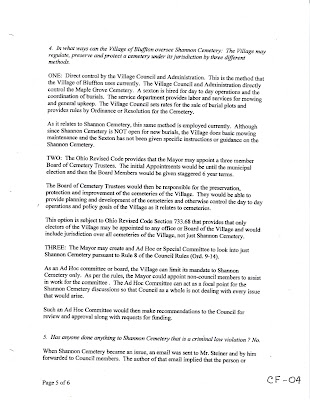Pondering the Ohio Revised Codes and specifically 2927.11 Desecration.
Note in (A):
"(A) No person, without privilege to do so, shall purposely deface, damage, pollute, or otherwise physically mistreat any of the following:"
*~*~*~*~*~*~*~*~*
Personally, I cannot think of any situations where someone would or should have privilege (and I understand "privilege" to mean having permission from owners) to "purposely deface, damage, pollute, or otherwise physically mistreat" a cemetery, i.e. including the property and/or gravesites and/or gravestones.
However, and this is a huge however, there could be situations where, for whatever reasons, and we can call being ignorant of what is right/good or wrong/bad, as reasons where an owner of a cemetery grants permission to a person or group of people to engage in conduct most of us would consider to be a desecration of a cemetery and that would mean that illegal desecration did not take place.
*~*~*~*~*~*~*~*~*
Thus, quite sadly, I can cite one recent example that I feel fits into this category. It is the current adverse issue affecting the Shannon Cemetery in Bluffton, Ohio where the village granted authority to an individual to purposely remove existing gravestones (including those for veterans) from gravesites at the Shannon Cemetery and store them in a storage facility to be later placed in concrete at another area of the Shannon Cemetery property to create a new "historic tombstone display."
This is because the person convinced the village that a "Cemetery Park" would be an improvement for the Village rather than allowing Shannon Cemetery to remain as it has been from the beginning - a cemetery - sacred ground which deserves our respect of being the final resting place for those who are interred in it.
So, yes, this removal of existing gravestones from gravesites did, in fact, occur and the decision to approve such an action was defended by the attorney for the Village of Bluffton in a six page letter citing, in part, ORC 2927.11.
Pages 5 and 6 of the multi-page letter of May 31, 2015, written by the Attorney for the Village of Bluffton, Ohio to the village's mayor and council members appears below.
**Please note the yellow highlighted area on the last page, Page 6, below.
What true value does an ORC (Ohio Revised Code) really have if five words in it can be used to defend an action that results in an outcome that would go against the statute? Removing existing gravestones under any other circumstances (without permission from an owner) would be considered in the category of: "purposely deface, damage ..." since gravesites would no longer be marked by their gravestones.
I feel that there are no Ohio Revised Codes in place that defend cemeteries against those who are in control of them yet do wrong by them through ill-conceived ideas that become actions that adversely affect them and the course of their future.
******************
Below is a link to ORC 2927.11 and its wording.:
*~*~*~*~*~*~*~*~*
Link:
http://codes.ohio.gov/orc/2927.11
2927.11 Desecration.
(A) No person, without privilege to do so, shall purposely deface, damage, pollute, or otherwise physically mistreat any of the following:
(1) The flag of the United States or of this state;
(2) Any public monument;
(3) Any historical or commemorative marker, or any structure, Indian mound or earthwork, cemetery, thing, or site of great historical or archaeological interest;
(4) A place of worship, its furnishings, or religious artifacts or sacred texts within the place of worship or within the grounds upon which the place of worship is located;
(5) A work of art or museum piece;
(6) Any other object of reverence or sacred devotion.
(B) Whoever violates this section is guilty of desecration. A violation of division (A)(1), (2), (3), (5), or (6) of this section is a misdemeanor of the second degree. Except as otherwise provided in this division, a violation of division (A)(4) of this section is a felony of the fifth degree that is punishable by a fine of up to two thousand five hundred dollars in addition to the penalties specified for a felony of the fifth degree in sections 2929.13 to 2929.18 of the Revised Code. If the value of the property or the amount of physical harm involved in a violation of division (A)(4) of this section is five thousand dollars or more but less than one hundred thousand dollars, a violation of that division is a felony of the fourth degree. If the value of the property or the amount of physical harm involved in a violation of division (A)(4) of this section is one hundred thousand dollars or more, a violation of that division is a felony of the third degree.
(C) As used in this section, "cemetery" means any place of burial and includes burial sites that contain American Indian burial objects placed with or containing American Indian human remains.
Effective Date: 09-20-1999


